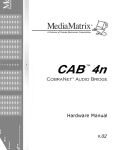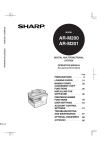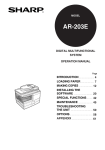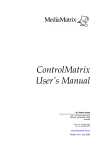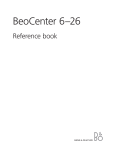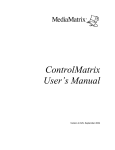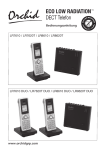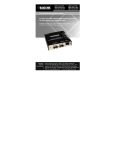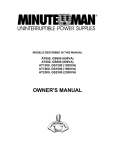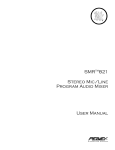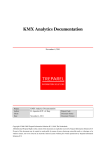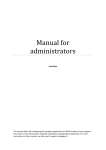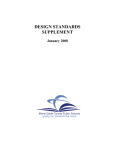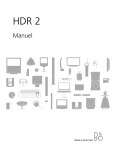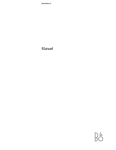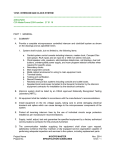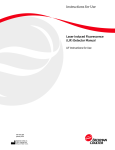Download Peavey 16D User's Manual
Transcript
CAB™ 16 Series CobraNet™ Audio Bridge CAB 16i CAB 16o CAB 16d User Manual Intended to alert the user to the presence of uninsulated “dangerous voltage” within the product’s enclosure that may be of sufficient magnitude to constitute a risk of electric shock to persons. Intended to alert the user of the presence of important operating and maintenance (servicing) instructions in the literature accompanying the product. CAUTION: Risk of electrical shock — DO NOT OPEN! CAUTION: To reduce the risk of electric shock, do not remove cover. No user serviceable parts inside. Refer servicing to qualified service personnel. WARNING: To prevent electrical shock or fire hazard, do not expose this appliance to rain or moisture. Before using this appliance, read the operating guide for further warnings. Este símbolo tiene el propósito, de alertar al usuario de la presencia de “(voltaje) peligroso” sin aislamiento dentro de la caja del producto y que puede tener una magnitud suficiente como para constituir riesgo de descarga eléctrica. Este símbolo tiene el propósito de alertar al usario de la presencia de instruccones importantes sobre la operación y mantenimiento en la información que viene con el producto. PRECAUCION: Riesgo de descarga eléctrica ¡NO ABRIR! PRECAUCION: Para disminuír el riesgo de descarga eléctrica, no abra la cubierta. No hay piezas útiles dentro. Deje todo mantenimiento en manos del personal técnico cualificado. ADVERTENCIA: Para evitar descargas eléctricas o peligro de incendio, no deje expuesto a la lluvia o humedad este aparato Antes de usar este aparato, Iea más advertencias en la guía de operación. Ce symbole est utilisé dans ce manuel pour indiquer à l’utilisateur la présence d’une tension dangereuse pouvant être d’amplitude suffisante pour constituer un risque de choc électrique. Ce symbole est utilisé dans ce manuel pour indiquer à l’utilisateur qu’il ou qu’elle trouvera d’importantes instructions concernant l’utilisation et l’entretien de l’appareil dans le paragraphe signalé. ATTENTION: Risques de choc électrique — NE PAS OUVRIR! ATTENTION: Afin de réduire le risque de choc électrique, ne pas enlever le couvercle. Il ne se trouve à l’intérieur aucune pièce pouvant être reparée par l’utilisateur. Confiez I’entretien et la réparation de l’appareil à un réparateur Peavey agréé. AVERTISSEMENT: Afin de prévenir les risques de décharge électrique ou de feu, n’exposez pas cet appareil à la pluie ou à l’humidité. Avant d’utiliser cet appareil, lisez attentivement les avertissements supplémentaires de ce manuel. Dieses Symbol soll den Anwender vor unisolierten gefährlichen Spannungen innerhalb des Gehäuses warnen, die von Ausreichender Stärke sind, um einen elektrischen Schlag verursachen zu können. Dieses Symbol soll den Benutzer auf wichtige Instruktionen in der Bedienungsanleitung aufmerksam machen, die Handhabung und Wartung des Produkts betreffen. VORSICHT: Risiko — Elektrischer Schlag! Nicht öffnen! VORSICHT: Um das Risiko eines elektrischen Schlages zu vermeiden, nicht die Abdeckung enfernen. Es befinden sich keine Teile darin, die vom Anwender repariert werden könnten. Reparaturen nur von qualifiziertem Fachpersonal durchführen lassen. ACHTUNG: Um einen elektrischen Schlag oder Feuergefahr zu vermeiden, sollte dieses Gerät nicht dem Regen oder Feuchtigkeit ausgesetzt werden. Vor Inbetriebnahme unbedingt die Bedienungsanleitung lesen. GENERAL CAUTIONS AND WARNINGS! To prevent electrical shock or potential fire hazards, do not expose the CAB 16 to moisture or rain. Before using this product, read the user manuals for further warnings and cautions. The following cautions should be carefully observed when installing, wiring or using this product: DO NOT use any other power supply or cable other than the one provided with this unit. DO NOT remove the top cover of the unit. There are no user serviceable parts inside. Refer service to qualified personnel. DO NOT use solvents or other cleaners to clean the unit. Basic external care requires only a damp cloth. Disconnect the power supply cord before cleaning. Read all safety and installation instructions and retain all documentation for further reference. The CAB 16 should be installed so that its mounting position does not interfere with proper ventilation. This product should not be installed or placed near a source of heat. Power supply cords and associated connectors should be unplugged from the power source when the unit is not used for long periods of time, or will be stored. If this product is to be mounted in an equipment rack, install rear support if required by the rack manufacturer. Care should be taken to ensure that the installation is clear of possible sources of contamination. Make sure that the product’s ventilation openings are not exposed to possible sources of liquid, gases, or other contaminants. This product should be inspected by a qualified service technician if the power supply cord or connector has been damaged, if the unit has been dropped, or if a foreign substance has gained access to the interior electronic and electrical components. The information contained in this manual is subject to change without notice. Peavey Electronics is not liable for improper installation or configuration. The information contained herein is intended only as an aid to qualified personnel in the design, installation and maintenance of engineered audio systems. The installing contractor or end user is ultimately responsible for the successful implementation of these systems. All creative content in this manual, including the layout, art design, content, photography, drawings, specifications and all other intellectual property is Copyright © 2000 Peavey Electronics Corporation, except where noted. All rights reserved. Manual by WR. CAB™ 16 Series User Manual Table of Contents Thank You! 7 What’s In The Box? 7 Covered Products 7 Features 8 Assumptions 8 Installation 9 Hardware vs. Software Devices 10 The Test View 11 Software Device Features CAB 16i 12 CAB 16o 13 CAB 16d 14-15 Panel Features CAB 16i Front Panel 16 CAB 16i Rear Panel 17 CAB 16o Front Panel 18 CAB 16o Rear Panel 19 CAB 16d Front Panel 20 CAB 16d Rear Panel 21 Connections CobraNet® 22 Audio 23 RS-485 23 S/PDIF 24-25 CAT 5 cable is your friend.... 26-27 Linking 28 Linking Examples 29 Setting The Hardware Base Address 30 Setting The CobraNet Audio Bundle 31 Testing, Testing..... 32-33 Testing, Testing.....Digital Style! 34-35 Tech Support & Warranty Registration 36 Additional Resources 37 Specifications Warranty Statement Page 4 38-39 40 http://aa.peavey.com copyright 2000 All Rights Reserved Table Of Contents Illustrations The CAB™ components and their relationships (Figure 1) ™ 10 The CobraNet audio transport devices and their control panels (Figure 2) 10 Recommended Test View Configuration (Figure 3) 11 Typical Network Connections (Figure 4) 22 Direct Connection Example (Figure 5) 22 Analog and Digital Audio Connections (Figure 6) 23 RS-485 Serial Data Connections (Figure 7) 23 S/PDIF resistor network configurations (Figure 8) 25 Standard “normal” CAT 5 cable (Figure 9) 26 CAT 5 Wire/Connector cross reference chart, standard & crossover cable types (Figure 10) 27 CAT 5 cable and RJ-45 termination details (Figure 11) 27 CAT 5 “crossover” cable (Figure 12) 27 CAB 16i Link Connection Example (Figure 13) 28 CAB 16o Link Connection Example (Figure 14) 29 CAB 16d Link Connection Example (Figure 15) 29 Hardware Base Address Switches (Figure 16) 30 Hardware & Software Addressing Controls (Figure 17) 30 CobraNet Input and Output Controls (Bundle Numbers in the OFF position) (Figure 18) 31 CAB Device Audio Bundle Number controls shown in the OFF position. (Figure 19) 31 Test Configuration (CAB 16i, CAB 16o) 32-33 Test Configuration (CAB 16d) 34-35 Peavey Electronics Corp. Page 5 CAB™ 16 Series User Manual CAUTION! The CAB 16 Series products are Ethernet (CobraNet™) network products designed to operate on a network backbone or infrastructure. The design, implementation and maintenance of this infrastructure is critical to the operation and performance of the CAB 16 Series products. Peavey Electronics does not support nor service network cabling, hubs, switches, patch bays, wall plates, connector panels or any other type of network interconnect device. Please ensure that these components and their associated installation techniques have been properly designed and installed for CobraNet audio applications. This manual is written specifically for the CAB 16 Series products built with Firmware Version 2.6.8. Specific functionality relating to earlier firmware is not covered in this manual. In the event that your CAB 16 includes an earlier firmware release, you should contact the Peavey Architectural Acoustics Technical Services Group for information on how this may, or may not, impact your installation. Installation or upgrading firmware within the CAB 16 is not covered in this manual. Several associated products are required to complete a working system using the CAB 16. This manual frequently makes reference to these other products, but does not provide specific configuration or installation information on them. Please refer to the manuals for these products for information. Every product, both Peavey products and third party devices, must be properly installed for the CAB 16 to operate in accordance with its published specification. This product is fan cooled with an intake fan on one side of the unit. The exhaust is located on the other side. Do not block the fan or any vents when installing this product. Proper cooling is essential to maintain proper operation and long-term stability in this product. Install this product in EIA approved equipment racks only. The information contained in this manual is subject to change without notice. Peavey Electronics is not liable for improper installation or configuration. The information contained herein is intended only as an aid to qualified personnel in the design, installation and maintenance of engineered audio systems. The installing contractor or end user is ultimately responsible for the successful implementation of these systems. Page 6 http://aa.peavey.com copyright 2000 All Rights Reserved Welcome Thank You! Thank you for purchasing the CAB™ 16 Series CobraNet™ Audio Bridge. This product is designed to provide years of trouble-free operation, and high quality audio performance. We sincerely hope that you enjoy your new CAB 16 Series product, and will find other products in the Peavey Architectural Acoustics product line to supplement your system. We are confident that you will find the CAB 16 Series products, as well as other Architectural Acoustics products to be of the highest quality available. This manual was written to provide as much information as possible for your new Peavey Architectural Acoustics product. It is our sincere desire that you enjoy your purchase. We feel that the best way to fully enjoy any purchase is to have an in-depth understanding of the product’s features, functionality and performance characteristics. We hope that this manual, along with the manuals of our other products, will provide this. If you require additional information that this manual does not provide, please let us know. We are always looking for better ways to provide information about our products, and your input is always appreciated. If you have a comment about this manual, or would like to make a suggestion, please write to: Peavey Electronics Corp., Architectural Acoustics Division, 711 A St., Meridian, MS 39301. Thank you again for using Peavey! What’s In The Box? The CAB 16 Series products are packaged in a single container. This container includes the following items: 1- CAB 16i, CAB 16o or CAB 16d CobraNet Audio Bridge 1- IEC removable power supply line cord (120VAC Domestic, 230VAC Export) 18- 3-screw Euro connectors* 1- User Manual/Literature Package * Asterisk indicates that these items are shipped installed on the CAB 16 Series product. If any of these items are missing, please contact your Authorized Peavey Architectural Acoustics contractor/dealer. Covered Products This User Manual covers the following CAB 16 Series products: CAB 16i CobraNet Audio Bridge and matching software devices for MediaMatrix. (16 line inputs) CAB 16o CobraNet Audio Bridge and matching software devices for MediaMatrix (16 line outputs) CAB 16d CobraNet Audio Bridge and matching software devices for MediaMatrix (8 digital audio (AES3 or S/PDIF) channels in and out) All of these products have similar feature sets and audio performance characteristics. This manual provides information on all products, and the differences are notated within the context of the subject matter. When the topic is common to both units, no differentiation is noted, nor required. Peavey Electronics Corp Page 7 CAB™ 16 Series User Manual Features - CobraNet™ ethernet audio transport - Single rack space package - Forced air cooling - Front panel analog audio metering - Front panel network status monitoring - 24 bit D/A and A/D converters - Discreet analog design - Digital control of analog functions - 16 line level inputs (16i only) - 16 line level outputs (16o only) - 8 AES3 or S/PDIF digital audio inputs and outputs (16d only) - Full analog gain stage w/digital control (except 16d) - User defined network hardware address - Removable connectors for audio and external controls - Industry standard RJ-45 connector for connecting to ethernet CobraNet network - RS-485 port for transporting serial data across the network - Support for stand alone operation In stand alone applications, the CAB 16 Series is a very powerful tool. Ease of use, external control options and a simple interface make it perfect for many applications where simple audio transport is required. Among the many applications the CAB 16 Series was designed for include: - Theme Parks - Presentation Rooms - Board Rooms - Courtrooms - Auditorium/Cafetorium - Lecture Hall Sound Reinforcement - Meeting Rooms - Convention Centers - Paging - Background Music - Retail Spaces - Restaurant/Bar Sound The CAB 16 Series is a prefect choice for many audio applications where transport of audio signal must occur over long distances. Used in conjunction with MediaMatrix products, the CAB 16 Series provides the highest level of audio systems performance, functionality and control. Assumptions Page 8 The CAB 16 Series of CobraNet Audio Bridges are designed for advanced MediaMatrix systems. It is assumed that you have a working knowledge of MediaMatrix hardware and software as well as computers, Windows NT and ethernet networks. If you do not have this knowledge, please refer the configuration and installation of this product to qualified personnel. For in-depth information on MediaMatrix, refer to the online help. Additional resources are listed in this manual. http://aa.peavey.com copyright 2000 All Rights Reserved Installation Installation The CAB™ 16 Series product is designed to mount in a standard EIA electronic equipment rack. Because the CAB 16 includes forced air cooling, adding rack mounted vent panels is not required for most installations. However, it is recommended that common sense be applied to large installations where multiple units are mounted in a single rack. It is generally accepted that a ratio of 2:1 is a good rule of thumb that usually provides adequate performance. In installations where adverse conditions exist, and room temperatures are likely to rise, additional vents should be installed. Do not block the fan or any vents when installing the CAB 16. Proper cooling is essential to maintain proper operation and long-term stability in this product. When dressing off wiring harnesses, take care with CAT 5 cables. Do not tie-wrap bundles of CAT 5 wire too tight. Leave plenty of room for bends, allowing the cable to progress naturally from the RJ-45 connector. Creating tightly wrapped CAT 5 wire bundles can cause loose crimp joints and defective terminations. To successfully install your new CAB 16 Series product, and perform the testing examples contained in this manual, you will need the following components: • A MediaMatrix® MiniFrame 208nt-cn or MM™-760nt, MM™-960nt or MM™-980nt Mainframe. • MWare 3.1.2 or later software. • PC Monitor, mouse and keyboard. • At least 1 MM™ DSP-cn CobraNet™ DPU card for MediaMatrix. • At least 1 CAB 16i and 1 CAB 16o CobraNet™ Audio Bridge, OR 2 CAB 16d CobraNet Audio Bridges. • At least 1 generic fast ethernet 100 Base T network switch*. • An assortment of CAT 5 cables. • An audio source, power amplifier and loudspeaker. In MediaMatrix, the minimum CobraNet network consists of a single MediaMatrix frame housing at least one MM DSP-cn CobraNet DPU card, CAB 16i and CAB 16o audio bridge and a single ethernet switch. Of course, most systems will include many more DSP-cn cards and CAB devices, but this is the most basic configuration. * The selection of a proper network switch is critical for a successful implementation. Although CobraNet is an ethernet protocol, there are performance issues that must be considered when selecting this switch for use in CobraNet audio systems. For the latest list of CobraNet compliant products, please refer to Peak Audio’s website at http://www.peak audio.com. Peavey Electronics Corp Page 9 CAB™ 16 Series User Manual Hardware vs. Software Devices The CAB 16 Series of products is an integration of physical hardware and software. Within CobraNet™, there are even further integrations, that being the network itself, and the actual piece of equipment, in this case, the CAB 16. In software, the equipment is represented by a “Device” within the MediaMatrix MWare application. The CobraNet network is represented by a traditional MediaMatrix wiring block with inputs and outputs. The “wire” between these blocks is the configuration of audio signal flow with the MediaMatrix’s DPU. For proper operation of these products, a thorough understanding of all of these devices is required. There is a very basic relationship between the CAB 16 physical product and its accompanying software device. Essentially, the software device is the “Control Panel” for the hardware. There are no physical controls on the CAB 16 itself, so all functions for it are accessible only from its software based control panel. This control panel is a yellowbox labeled “CAB 16”, and can be found under the Input/Output, CobraNet section of the Device Menu within the MediaMatrix software. There is one for each model of CAB 16 product. I like to refer to this device as the “Taxi”, since it’s a yellow CAB......get it? The figure below shows the relationship between the Taxi, its control panel and the actual CAB hardware. Fig. 1, The CAB components and their relationships. The second half of this equation, as mentioned above, is the audio transport. This transport is the CobraNet network that carries audio from one location to another. Within MediaMatrix, this is represented by a block with “wire nodes” on it that represent the actual input and output points for the system. What is very important to note is that the hardware unit, the CAB itself, and the audio transport device DO NOT necessarily match up. For example, it is possible to have one output wiring block assigned to multiple CAB 16o units although generally, the input side is always a one-to-one relationship. In the figure below, you can see the two network blocks. The one with the nodes on the right of the block is an audio “input” position, the one with the nodes on the left side of the block is an audio “output” position. Each of these also has a control panel. The control panels for each are very similar, so don’t get them mixed up. You can tell which one is the “input” side by the “Receiving” label on the channel LEDs. These LEDs indicate that an audio data stream is successfully being received from a distant network location. Input Side of Audio Path CobraNet Input Control Panel Output Side of Audio Path CobraNet Output Control Panel Fig. 2, The CobraNet audio transport devices and their control panels. Page 10 http://aa.peavey.com copyright 2000 All Rights Reserved Hardware & Software The Test View In order to properly use this manual, it is recommended that a basic MediaMatrix view file be configured. This view file should have a minimum number of components and should include one each of the CAB™ 16i and CAB 16o, or, it should match exactly your specific system hardware. The following figure is a good example of such a “test” file. CobraNet Status Tool CobraNet transport device Audio from the “outside” enters the MediaMatrix system here. The yellow CAB device...the “taxi” These wires carry digital audio within the MediaMatrix system. Audio to the “outside” exits the MediaMatrix system here. Fig. 3, Recommended Test View Configuration Once again....to summarize. It is very important to understand the relationship between the CAB hardware, it’s associated software control software and the CobraNet™ network, or “audio transport”. The blocks in this example labeled CobraNet 1A, 1B, etc. are transport blocks that receive digital audio from, and carry digital to, distant CobraNet network locations. This audio enters and exits the MediaMatrix system at these blocks. The wires represent the digital audio path within the MediaMatrix system. The blocks labeled CAB, the yellow “Taxi”, represent the actual CAB hardware. There must be one of these for each corresponding hardware piece. The hardware, via its control panel, can be “assigned” to any network audio channel, called a “bundle”. This bundle is also assigned in the CobraNet transport block. It is this bundle assignment that gets the audio from the CAB’s analog port and onto the network. If this is confusing to you, stop and re-read this section. It is vital to your ability to successfully implement a CobraNet audio system using MediaMatrix products. If you understand it....kinda, but still need help, read on....you’ll see how it all fits together as you start hooking up CABs and passing audio from point to point. Peavey Electronics Corp Page 11 CAB™ 16 Series User Manual CAB 16i Software Device Features LINK LED This LED will turn ON when a valid connection has been established between the CAB 16 and the network switch. This function is duplicated on the front panel of the CAB 16i. ID The four digit number is the user-defined Hardware Base Address. The range is hex, between 0000 and FFFF. The LED will turn ON when a valid number is entered. Each CAB 16 on the network must have a unique ID. If there is a duplicate, or the value is zero, this LED will not light, and communications between the CAB and network is not valid. BUNDLE User defined number that assigns eight audio channels to a CobraNet™ network “bundle”. The range is OFF to 32,767. For switched networks, the number must be 256 or higher. This number must also be set in the CobraNet I/O device for which the CAB will transport audio. The LED is ON when the CAB 16i is receiving the specified network bundle. Each CAB 16i can receive two separate audio bundles. GAIN Software control of the CAB 16i’s analog gain stage. Gesturable from the knob or the digital window located just above each knob. The range is -95.5 dB to +30.5 dB. FULL-SCALE SENSITIVITY BLOCK When clicked upon, this block opens an additional window that includes buttons for adjusting the CAB 16i’s input sensitivity. There are two windows, one for channels 1-8, and another for channels 9-16. A single-click in Control Mode, or a double-click in Edit Mode will open this block. FULL-SCALE SENSITIVITY DIALOG This window reveals the CAB 16i’s input channel analog sensitivity settings. There are four settings for each input channel. The levels indicate a maximum setting and allow the user to “shift” the available dynamic range for flexibility in matching nominal incoming signal levels. When the GAIN control is at 0 dB, the input sensitivity is determined solely by the Full Scale Sensitivity button. Page 12 http://aa.peavey.com copyright 2000 All Rights Reserved Software Features CAB 16o Software Device Features LINK LED This LED will turn ON when a valid connection has been established between the CAB™ 16 and the network switch. This function is duplicated on the front panel of the CAB 16o. ID The four digit number is the user-defined Hardware Base Address. The range is hex, between 0000 and FFFF. The LED will turn ON when a valid number is entered. Each CAB 16 on the network must have a unique ID. If there is a duplicate, or the value is zero, this LED will not light, and communications between the CAB and network is not valid. BUNDLE User defined number that assigns eight audio channels to a CobraNet™ network “bundle”. The range is OFF to 32,767. For switched networks, the number must be 256 or higher. This number must also be set in the CobraNet I/O device for which the CAB will transport audio. The LED is ON when the CAB 16o is transmitting the specified network bundle. Each CAB 16o can transmit (send) two separate audio bundles. MUTE This single button will mute all audio outputs in the digital domain. This button is independent of the output GAIN control. GAIN Software control of the CAB 16o’s analog output stage. Gesturable from the knob or the digital window located just above each knob. The range is -95.5 dB to +30.5 dB. FULL-SCALE SENSITIVITY BLOCK When clicked upon, this block opens an additional window that includes buttons for adjusting the CAB 16o’s output scale. There are two windows, one for channels 1-8, and another for channels 9-16. A single-click in Control Mode, or a double-click in Edit Mode will open this block. FULL-SCALE SENSITIVITY DIALOG This window reveals the CAB 16o’s output channel analog settings. There are four settings for each output channel. The levels indicate a maximum setting and allow the user to “shift” the available dynamic range for flexibility in matching the input sensitivity of the power amplifier input. When the GAIN control is at 0 dB, the input sensitivity is determined solely by the Full Scale Output button. Peavey Electronics Corp Page 13 CAB™ 16 Series User Manual CAB 16d Software Device Features LINK LED This LED will turn ON when a valid connection has been established between the CAB 16 and the network switch. This function is duplicated on the front panel. ID The four digit number is the user-defined Hardware Base Address. The range is hex, between 0000 and FFFF. The LED will turn ON when a valid number is entered. Each CAB 16 on the network must have a unique ID. If there is a duplicate, or the value is zero, this LED will not light, and communications between the CAB and network is not valid. METER INPUTS This switch along with the METER OUTPUT switch toggles the CAB 16d’s front panel audio meters between digital inputs and digital outputs. This function is duplicated on the front panel of the CAB 16d. DISABLE OUTPUTS This switch turns off the AES transmitters so that no valid AES data is output from the box. This is different from Muting outputs in that muting stops audio data but maintains valid AES output. BUNDLE User defined number that assigns eight audio channels to a CobraNet™ network “bundle”. The range is OFF to 32,767. For switched networks, the number must be 256 or higher. This number must also be set in the CobraNet I/O device for which the CAB will transport audio. The LED is ON when the CAB 16d is receiving the specified network bundle. Each CAB 16d can receive two separate audio bundles. CHANNEL STATUS BLOCK Each audio bundle includes a Channel Status block. A singleclick in Control Mode, or a double-click in Edit Mode will open the block. When open, this block contains status indicators and controls for digital audio performance parameters for each audio bundle. The windows include separate functionality for input and output bundles. Page 14 http://aa.peavey.com copyright 2000 All Rights Reserved Software Features CAB 16d Software Device Features (Input & Output Status Panels) ERROR Indicates an error has been detected on the incoming audio data stream. There is a single LED for each digital channel (2 audio channels each). SAMPLE RATE CONVERTER DISABLE Disables the on-board sample rate converters. The audio source must be locked to the CobraNet network for audio to be valid and lock. FORMAT Indicates if digital source consumer or professional grade product. Applies to each digital channel. EMPHASIS Indicates status of emphasis. The options are “Not Indicated” which means that the emphasis status is not specified. “None” means that there is no emphasis. “50/15” indicates that the signal contains 50/15 us and CCIT J.17 indicates that CCITT J.17 is used. SAMPLE RATE Indicates the sample rate of the incoming AES data stream. This is the sample rate of the input signal, before conversion. LOCK Indicates the CAB™ has locked to the incoming audio data stream. COPY The copy bit on the AES audio stream is set. AUDIO Indicates that valid audio data has been detected on the inputs. OUTPUT CHANNEL DISABLE This switch turns off the AES transmitters so that no valid AES data is output from the box. This is different from Muting outputs in that muting stops audio data but maintains valid AES output. OUTPUT CHANNEL FORMAT Indicates if digital source consumer or professional grade product. Applies to each digital channel. OUTPUT CHANNEL EMPHASIS Indicates status of output emphasis. The options are “Not Indicated” which means that the emphasis status is not specified. “None” means that there is no emphasis. “50/15” indicates that the signal contains 50/15 us and CCIT J.17 indicates that CCITT J.17 is used. Peavey Electronics Corp Page 15 CAB™ 16 Series User Manual CAB 16i Front Panel Features 1 1 2 3 4 5 6 7 8 9 10 11 1. AUDIO METERS Peak reading LED ladder displays indicating audio input level in the analog domain. Signal level is displayed after the adjustable gain stage and before the A/D converters. 2. HARDWARE BASE ADDRESS SWITCHES 4-position rotary switches for setting the hardware base address. Shown with tamperproof cover removed. 3. TX LED Indicates the presence of data being transmitted (sent) from the CAB 16 onto the CobraNet™ network. 4. RX LED Indicates the presence of data being received into the CAB 16 from the CobraNet network. 5. TX ERROR LED Indicates an error occurred during transmission of data from the CAB 16 onto the CobraNet network. 6. RX ERROR LED Indicates that an error occurred while receiving data into the CAB 16 from the CobraNet network. 7. FAULT LED Illumination of the Fault indicator indicates detection of an unexpected condition within the CobraNet interface. Some fault conditions will also light the RX Error and/or TX Error indicators to give more specific indication if the unexpected condition is in the receive or transmit processes. The errors are reported by a series of flashes. See page 37 for help on identifying error codes for the CAB 16. 8. LINK LED Indicates a valid control link has been established between the CAB 16 and the network switch. This function is duplicated in the software control panel. 9. CONDUCT LED Indicates the CAB 16 is an active conductor on the CobraNet network. Only one conductor is allowed per network. 10. RS-485 LED Indicates activity on the RS-485 bus. This LED should be OFF during idle conditions and should blink ON during normal activity. (If this LED stays ON during idle, it may indicate an RS-485 conductor polarity inversion.) 11. POWER LED Indicates that the CAB 16 is powered from an AC mains power source. Page 16 http://aa.peavey.com copyright 2000 All Rights Reserved Panel Features CAB 16i Rear Panel Features (shown without the Euro connectors attached) 1 2 3 4 5 6 7 7 1. IEC POWER CABLE RECEPTACLE The included removable IEC power cable connects here. Use only the supplied cable. 2. POWER SWITCH Applies mains AC power to the CAB™ 16. 3. LINK OUT CONNECTOR BNC connector to transmit link data to other CAB units or third party synchronization products. 4. LINK IN CONNECTOR BNC connector that receives link data from other CAB units or third party synchronization products. 5. COBRANET NETWORK I/O RJ-45 connector provides interface to the CobraNet™ audio network. This connection is required to pass audio with the CAB 16. 6. RS-485 PORT Two two-wire, half-duplex RS-485 connections on removable Euro connectors. Each connector is internally wired together for convenient busing of adjacent units. 7. AUDIO INPUT CONNECTORS Balanced, three-wire line level audio input connections on removable Euro connectors. This illustration shows the connector header only. The unit is shipped with matching black pluggable connectors for each audio channel. Peavey Electronics Corp Page 17 CAB™ 16 Series User Manual CAB 16o Front Panel Features 1 1 2 3 4 5 6 7 8 9 10 11 1. AUDIO METERS Peak reading LED ladder displays indicating audio input level in the analog domain. Signal level is displayed after the adjustable gain stage and before the A/D converters. 2. HARDWARE BASE ADDRESS SWITCHES 4-position rotary switches for setting the hardware base address. Shown with tamperproof cover removed. 3. TX LED Indicates the presence of data being transmitted (sent) from the CAB 16 onto the CobraNet™ network. 4. RX LED Indicates the presence of data being received into the CAB 16 from the CobraNet network. 5. TX ERROR LED Indicates an error occurred during transmission of data from the CAB 16 onto the CobraNet network. 6. RX ERROR LED Indicates that an error occurred while receiving data into the CAB 16 from the CobraNet network. 7. FAULT LED Illumination of the Fault indicator indicates detection of an unexpected condition within the CobraNet interface. Some fault conditions will also light the RX Error and/or TX Error indicators to give more specific indication if the unexpected condition is in the receive or transmit processes. The errors are reported by a series of flashes. See page 37 for help on identifying error codes for the CAB 16. 8. LINK LED Indicates a valid control link has been established between the CAB 16 and the network switch. This function is duplicated in the software control panel. 9. CONDUCT LED Indicates the CAB 16 is an active conductor on the CobraNet network. Only one conductor is allowed per network. 10. RS-485 LED Indicates activity on the RS-485 bus. This LED should be OFF during idle conditions and should blink ON during normal activity. (If this LED stays ON during idle, it may indicate an RS-485 conductor polarity inversion.) 11. POWER LED Indicates that the CAB 16 is powered from an AC mains power source. Page 18 http://aa.peavey.com copyright 2000 All Rights Reserved Panel Features CAB 16o Rear Panel Features (shown without the Euro connectors attached) 1 2 3 4 5 6 7 7 1. IEC POWER CABLE RECEPTACLE The included removable IEC power cable connects here. Use only the supplied cable. 2. POWER SWITCH Applies mains AC power to the CAB™ 16. 3. LINK OUT CONNECTOR BNC connector to transmit link data to other CAB units or third party synchronization products. 4. LINK IN CONNECTOR BNC connector that receives link data from other CAB units or third party synchronization products. 5. COBRANET NETWORK I/O RJ-45 connector provides interface to the CobraNet™ audio network. This connection is required to pass audio with the CAB 16. 6. RS-485 PORT Two two-wire, half-duplex RS-485 connections on removable Euro connectors. Each connector is internally wired together for convenient busing of adjacent units. 7. AUDIO OUTPUT CONNECTORS Balanced, three-wire line level audio output connections on removable Euro connectors. This illustration shows the connector header only. The unit is shipped with matching black pluggable connectors for each audio channel. Peavey Electronics Corp Page 19 CAB™ 16 Series User Manual CAB 16d Front Panel Features 1 2 2 3 4 5 6 7 8 9 10 11 12 1. METER SELECT This meter toggles in the function of the front panel audio meters between input and output. The corresponding LED indicates the active meter function. 2. AUDIO METERS Peak reading, switchable LED ladder displays indicating audio level in the digital domain. These meters indicate input OR output level depending on the position of the front panel METER SELECT switch and/or the Meter Input and Meter Output switches in the CAB 16d Software Device dialog box (p 14). 3. HARDWARE BASE ADDRESS SWITCHES 4-position rotary switches for setting the hardware base address. Shown with tamperproof cover removed. 4. TX LED Indicates the presence of data being transmitted (sent) from the CAB 16 onto the CobraNet™ network. 5. RX LED Indicates the presence of data being received into the CAB 16 from the CobraNet network. 6. TX ERROR LED Indicates an error occurred during transmission of data from the CAB 16 onto the CobraNet network. (See Appendix, Error Reporting.) 7. RX ERROR LED Indicates that an error occurred while receiving data into the CAB 16 from the CobraNet network. (See Appendix, Error Reporting.) 8. FAULT LED Illumination of the Fault indicator indicates detection of an unexpected condition within the CobraNet interface. Some fault conditions will also light the RX Error and/or TX Error indicators to give more specific indication if the unexpected condition is in the receive or transmit processes. The errors are reported by a series of flashes. See page 37 for help on identifying error codes for the CAB 16. 9. LINK LED Indicates a valid control link has been established between the CAB 16, the cable plant and the network switch. This function is duplicated in the software control panel. 10. CONDUCT LED Indicates the CAB 16 is an active conductor on the CobraNet network. Only one conductor is allowed per network. 11. RS-485 LED Indicates activity on the RS-485 bus. This LED should be OFF during idle conditions and should blink ON during normal activity. (If this LED stays ON during idle, it may indicate an RS-485 conductor polarity inversion.) 12. POWER LED Indicates that the CAB 16 is powered from an AC mains power source. Page 20 http://aa.peavey.com copyright 2000 All Rights Reserved Panel Features CAB 16d Rear Panel Features (shown without the Euro connectors attached) 1 2 3 4 5 6 7 8 1. IEC POWER CABLE RECEPTACLE The included removable IEC power cable connects here. Use only the supplied cable. 2. POWER SWITCH Applies mains AC power to the CAB™ 16. 3. LINK OUT CONNECTOR BNC connector to transmit link data to other CAB units or third party synchronization products. 4. LINK IN CONNECTOR BNC connector that receives link data from other CAB units or third party synchronization products. 5. COBRANET NETWORK I/O RJ-45 connector provides interface to the CobraNet™ audio network. This connection is required to pass audio with the CAB 16. 6. RS-485 PORT Two two-wire, half-duplex RS-485 connections on removable Euro connectors. Each connector is internally wired together for convenient busing of adjacent units. 7. AUDIO INPUT CONNECTORS Balanced, three-wire digital (AES3) audio input connections on removable Euro connectors. This illustration shows the connector header only. The unit is shipped with matching black pluggable connectors for each header bay. 8. AUDIO OUTPUT CONNECTORS Balanced, three-wire digital (AES3) audio output connections on removable Euro connectors. Each digital channel carries two audio channels. This illustration shows the connector header only. The unit is shipped with matching black pluggable connectors for each audio channel. Peavey Electronics Corp Page 21 CAB™ 16 Series User Manual Basic CobraNet Network Connections The CAB 16 Series products feature 4 different connection types. (Refer to the Rear Panel Details.) First in priority is the CobraNet™ network port. This RJ-45 connector is designed to connect with standard, off-the-shelf Category 5 (CAT 5) cable for use with standard Ethernet network switches. This cabling interconnect is commonly referred to as the wiring “backbone”. This backbone must be properly designed for each system. Ideally, this cabling and its associated hardware would be designed, installed and certified by a competent network systems engineer. A typical CobraNet system would include a CAT 5 cable from each CAB 16 to a network switch. An additional CAT 5 cable would connect the switch to one or more MM-DSP-cn cards within the MediaMatrix frame. The example below is the most basic configuration. Large systems on managed networks can get very complex. Please don’t get ahead of yourself here! You need to be able to make this configuration work first! MediaMatrix Frame with one MM-DSP-cn DPU Card Standard CAT5 Cable 100 Base T Network Switch CAB 16o CAB 16i Fig. 4, Typical Network Connections Alternately, you can connect the CAB 16 CobraNet port directly to the CobraNet port on your MM-DSP-cn card, bypassing the need for a switch. However, this type of direct connection requires a "crossover" cable. (See p. 26-27 for CAT 5 cable details.) It should be emphasized that with this direct connection method, you cannot connect more than a single CAB product to an MMDSP-cn card. This type of connection is normally used for testing and troubleshooting and has limited advantages in actual system installations. MediaMatrix Frame with MM-DSP-cn DPU Card “Crossover” CAT5 Cable (See p. 26-27) CAB 16o Fig. 5, Direct Connection Example Page 22 http://aa.peavey.com copyright 2000 All Rights Reserved Audio & RS-485 Connections Audio Connections The second connection is audio. Each audio connection on the CAB™ 16i and 16o is a single three-wire, balanced analog circuit. The connections on both of these units is identical, except one is an input, the other an output. The method is the same. For the CAB 16d however, the method is slightly different. Each three wire connection on the 16d is a balanced, two-channel digital (AES3 or S/PDIF, see p. 24-25) connection. AES3 compliant cable should be used with all connections on the 16d. As with any electronic connection, care should be taken to ensure that the termination is solid. There should be no stray wire strands, kinks or nicks in the wire jacket for a proper termination. And as always, audio connections should be made with high quality shielded wire. Analog (16i) Balanced Input Positive (+) Negative (-) Shield (SH) Standard audio cable Digital (16d) Two Channel Conn. Positive (+) Negative (-) Shield (SH) AES3 / 110 Ohm cable Analog (16o) Balanced Output Positive (+) Negative (-) Shield (SH) Standard audio cable Fig. 6, Analog and Digital Audio Connections RS-485 Connections The third connection is the CAB Series RS-485 Serial Port. All CAB Series products include this powerful feature that enables you to “bridge” serial data between CAB locations on the CobraNet™ network. You can think of this as a kind of “sub-network” that travels across the CobraNet infrastructure independently of the audio data. This feature has many uses, but is primarily used to transport control data for the optional AmpWare amplifier control and monitoring software. In this case, the connection would terminate directly to an IA™ Series power amplifier equipped with an ACI™-485V interface module. The data format is Half-Duplex, two-wire, balanced. Again, care should be taken to insure that your termination is correctly installed and high quality shielded wire should be used. NOTE: The RS-485 connector has two sets of terminations that are wired in parallel. This allows you to “bus” adjacent serial data connections at each network location. With this type of connection, there is no “input” or “output”. ...here Plug this..... Balanced Connection Positive (+) Negative (-) Shield (SH) From RS-485 Device To Next RS-485 Device Fig. 7, RS-485 Serial Data Connections Peavey Electronics Corp Page 23 CAB™ 16 Series User Manual Using S/PDIF with the CAB 16d The CAB 16d has been designed for use with AES3 (AES/EBU) and S/PDIF (Sony/Philips Digital Interface Format) digital audio signals. The CAB 16d is shipped from the factory to accommodate AES3 digital audio right out of the box. You can connect AES sources directly to the CAB 16d’s input and output terminals without any regard to additional interface boxes or converters. When using S/PDIF digital audio signals however, it is recommended that the following interface circuits be used between the S/PDIF audio device and the CAB 16d. There are differences in the voltage levels, load and cable impedance between AES3 and S/PDIF formats. Using these “matching interfaces” will ensure seamless operation of S/PDIF digital audio by minimizing signal reflections and providing correct signal levels for S/PDIF operation. The following illustrations show S/PDIF terminations to the CAB 16d’s input and output connectors. The S/PDIF connections are illustrated as unbalanced consumer RCA connectors, which is typically the standard connector for copper based S/PDIF wiring. There is also an optical version of the S/PDIF standard which uses a fiber cable that is not a part of this discussion. It is important to know that the audio data is the same in both AES3 and S/PDIF formats, but because of the differences in their subcode, they are actually different formats. Just making a wire conversion is not enough. AES3 on an XLR connector converted to an unbalanced RCA connector is NOT S/PDIF, and vice versa. The native formats are still the same, only the transport media has changed. To make sure that your S/PDIF audio signals work correctly with the CAB 16d, it is required that these circuits be installed between the S/PDIF devices and the CAB 16d. Wire & Cable An important fact of digital audio transport is that the wire type is significantly different than wire used for terminating analog audio circuits. AES3 uses symmetrical connections with transformer isolation and an output impedance of 110 Ohms. The signal-level of this interface is higher than in the consumer S/PDIF version. Because AES3 digital audio signals are transmitted at high, video-like frequencies, they should be handled very differently than standard analog audio lines. Failure to use the proper wire and cable can cause poor digital transmission performance resulting in signal dropout. With proper termination, AES3 signal transmission lines can easily exceed several thousand feet when using high quality, certified cable. S/PDIF however, uses 75 Ohm coaxial cable. Because it is the same type of cable used in common consumer video circuits, this type of wire is inexpensive and readily available. You can even buy pre-made S/PDIF cables at most retail outlets that sell consumer electronics products. By specification, the maximum length of a properly terminated S/PDIF cable is 25 feet. If high quality 75 Ohm cable with premium gold 75 Ohm RCA connectors are used, it is possible to get good results with much longer lines. The actual lengths are unknown however, since it depends on the quality of the transmitting circuit, the receiving circuit and the impedance match for the entire line, including the connectors. In general, coaxial S/PDIF connections work best in the 8-10 meter range with good 75 Ohm coaxial cable. We do not recommend that you exceed this distance when using S/PDIF devices with the CAB 16d. Page 24 http://aa.peavey.com copyright 2000 All Rights Reserved S/PDIF Connections When making these interface connections, it is important to install the resistors at the CAB™ 16d’s output terminal, using the removable Euro connector. The design of this connector, supplied with the CAB 16d, will provide a solid mechanical mount for the resistors. The wiring from the consumer RCA coax cable should be soldered to the other side of the resistor network. All interconnecting joints should be soldered as well. All resistors should be 1% or 5% tolerance, 5 W, typical. Connecting an S/PDIF Source to a CAB 16d input requires that the output level and impedance of the S/PDIF source be matched to the CAB 16d’s input circuit. The following circuit provides attenuation from the source through one in-line 51 Ohm resistor on the positive leg of the signal. The impedance matching is accomplished by using a 150 Ohm resistor across both legs of the S/PDIF source signal. NOTE: A jumper is required between the negative and SH terminals to complete the termination. To drive an S/PDIF input from the CAB 16d’s output, a similar circuit must be implemented. Again, the impedance of the CAB 16d must be matched to properly terminate to the S/PDIF input. This is accomplished by using a 22 Ohm resistor across the output of the CAB 16d. The level correction is accomplished by placing a 75 Ohm and a 56 Ohm resistor in series with the positive side of the CAB 16d’s output as shown. The negative side is carried straight through to the shield conductor of the S/PDIF device’s input. (Jumper is optional.) Jumper 51 Ohm resistor 75 Ohm resistor Negative/Shield 22 Ohm resistor 56 Ohm resistor 150 Ohm resistor Positive “Hot” wire Unbalanced Coax RCA connector From S/PDIF output To S/PDIF input Fig. 8, S/PDIF resistor network configurations In addition to adding the resistor circuits, it may also be necessary to configure the CAB 16d output CHANNEL STATUS to Consumer Mode before the interface between the S/PDIF device and CAB 16d is completed. The Consumer Mode Select Switch can be found in the CAB 16d CHANNEL STATUS BLOCK, located within the CAB 16d’s software control panel. (See pages 14-15.) Peavey Electronics Corp Page 25 CAB™ 16 Series User Manual CAT 5 cable is your friend.... Well, you’ve been in the audio business for a while now....you know all about audio connections, balanced cables, multi-pairs, SJO, TRS this and XLR that....you can dress off a wiring harness like nobody’s business....then, the industry throws “CAT 5” at you....! So, what exactly is Category 5 cabling, and how do I terminate it? Category 5 cable, or “CAT 5” as it is commonly known, is a wiring standard that became popular when computer networks moved from a “bus” topology to a “star” or...... “every box is a home run” topology. The wire itself consists of 8 conductors, identified into 4 pairs, and although only two of these pairs are actually used, all four are terminated. It is a UTP (Unshielded Twisted Pair) configuration, in true telco, or AT&T style. The cable is coupled to in-line RJ-45 connectors, also a Bell/AT&T standard. Special crimping tools are required to make the termination, and are available everywhere, as are the connectors. Oh...and before you start designing cable plants for small cities....a single CAT 5 cable run should not exceed 100 meters. Just like telco wire, there are stranded and solid varieties of CAT 5 cable. This is important to know, because the RJ-45 connector is different for each type of wire. The standard “bent tyne” style connector is intended for use with solid core wire, and the “aligned tyne” connector is for use with standard wire. There have been errors when using incorrect cable/connector combinations, so be careful. The "bent tyne" connector will generally work on stranded wire by the way, but not the other way around. In general, make sure your connector matches your cable type. If you aren’t sure, use the “bent tyne” variety. When terminating CAT 5 cable, it is important that the natural twist of each pair be carried through as close as possible to the point of termination at the connector. The EIA standard requires no more than 1/2 inch be left untwisted. More than 1/2 inch of untwisted cable will affect performance at high bit rates. Although only 2 of the 4 twisted pairs are used for Ethernet, it is important that all pairs be terminated, and that the conductors be twisted together in pairs. The illustrations should give you the basics for getting your cables, and your audio system up and running. Although pre-made, molded style cables are preferred, they are usually impractical, since your cabling route, distance and locations are based on the jobsite conditions and not your test bench. Additionally, you will need rack wiring, and bulk cable is the preferred way to dress off a wire harness, as we all know. Since this manual is printed in grayscale, you will not be able to see the color code of the wire. We have labeled them for your convenience, but you should get familiar with the color schemes so they are second nature to you. An error in the cabling of your audio network is often the primary cause of system errors, so....take your time, learn it thoroughly and DO IT RIGHT THE FIRST TIME! Although the wiring standard used in CAT 5 cabling originates with AT&T, it is functionally different for configuring ethernet cabling. The Bell System uses a series of colors to indentify wire pairs. This color scheme identifies the pair numbers, and conductor polarity, and applies to the WIRE....not the connector. It is important to know what pairs are which, and the function of the pins on the RJ-45 connector. The colors are BLUE, ORANGE, GREEN and BROWN for the first four pairs. The color Brown Pair Pin 8 Pin 1 Green Pair Green Pair Blue Pair Orange Pair Orange Pair Blue Pair Pin 1 Pin 8 Brown Pair Fig. 9, Standard “normal” CAT 5 cable code extends well beyond that, but since we are only dealing with 4 pairs of wire, you don’t need to know the entire Bell System color code for terminating a 900 pair distribution trunk...! What is often confusing is that the pair numbers do not line up with the pin numbers on the RJ-45 connector. In other words, conductor ONE of the cable (White w/Blue Strip) is NOT terminated to PIN ONE of the connector. The AT&T connecting standard always uses the middle pins for the first pair. After that, they are staggered around, primarily to prevent crosstalk between adjacent pairs. For ethernet, and for use with the CAB 16, only the ORANGE and GREEN pairs are actually used. BUT...it is very important that you build the cable with ALL PAIRS properly terminated. This will prevent any confustion later, and give your cable a solid mechanical connection. Page 26 http://aa.peavey.com copyright 2000 All Rights Reserved CAT 5 Cables Remember, for ethernet, the BLUE and BROWN pairs are not used. The ORANGE pair is transmit (TX), and the GREEN pair is receive (RX). There is a positive and negative conductor for each pair, indicated by the color code. Notice on the chart that the order of the wire pairs does not follow the connector pins, as mentioned earlier. Don’t let that confuse you. The first wire of a given pair is always the white wire with a colored stripe and is the positive conductor. The corresponding colored wire with the white stripe is the negative conductor for that pair. RX Pair + TX Pair + Pins (1-8) Crossover Cables Normal CAT 5 cables are designed to connect the CAB™ 16 to a network switch only. You cannot use this type of cable to connect a CAB 16 directly to a MediaMatrix MM-DSP-cn DPU card. For that you need a “crossover” cable. The pin assignments for a crossover cable, shown in parentheses on the chart, apply to ONE END of the cable ONLY! Conductor Wire Pair Connector Pin Function White w/blue stripe Blue w/white stripe White w/orange stripe Orange w/white stripe White w/green stripe Green w/white stripe White w/brown stripe Brown w/white stripe 1 1 2 2 3 3 4 4 5 4 1 (3 x-over) 2 (6 x-over) 3 (1 x-over) 6 (2 x-over) 7 8 Not used Not used TX + TX RX + RX Not used Not used Fig. 10, CAT 5 Wire/Connector cross reference chart, standard & crossover cable types. Conductors RJ-45 Shell Jacketed Cable Fig. 11, CAT 5 cable and RJ-45 termination details Crossover cables are used to connect switches to other switches or CAB 16s directly to the DPU card. Also, a crossover cable is what you would use if you were to connect a CAB 16 to another CAB 16, for use as a digital “snake”. A crossover cable is terminated the same way as a normal cable, except that the TX and RX pins are "swapped" at one end to allow the transmit pair of one device to connect to the receive pair of the other. Normally, this crossover action is done within the switch, which is why you use a straight-through cable most of the time. It is very easy to tell the difference between a crossover cable and a straight-through cable by looking at the conductors in the RJ-45 connectors. If the wiring is identical at both ends, you are looking at a straight-through cable. If it is different, you most likely have a crossover cable, or possibly, an incorrectly terminated cable. Look carefully at the color of the conductors. It is important to note that some switches include “uplink” ports. These ports are intended to serve as a connection to another switch. As such, the uplink port is wired to use a straight-through cable instead of requiring a crossover cable. On some switches, uplink ports share their connection with an adjacent port, so be sure to read the manufacturer's instructions for proper use. Brown Pair Pin 8 Pin 1 Green Pair Orange Pair Green Pair Blue Pair Blue Pair Brown Pair Orange Pair Pin 1 Pin 8 Fig. 12, CAT 5 “crossover” cable Peavey Electronics Corp Page 27 CAB™ 16 Series User Manual Link Connections All CAB Series products feature built-in “Buddy Link” functionality for creating backup I/O configurations in mission critical systems. The term “Buddy Link” extends to multiple dimensions within MediaMatrix, but in this context, we are concerned only with how the built-in Buddy Link works with the CAB 16 Series products. For more detailed information on how Buddy Link works with MediaMatrix and/or CobraNet™, please refer to our website, or to the resource list at the end of this manual. Each CAB 16 Series product features rear panel, dual BNC connectors labeled LINK IN and LINK OUT. These connectors enable you to connect adjacent, CAB units for redundancy and define the role of dual units. In this configuration, one CAB is declared the primary and transmits data via its LINK OUT connector. The other CAB is the secondary, or backup, and receives data at its LINK IN connector. A high quality, broadcast grade video cable, RG-59 with male BNC connectors on each end is used to make the connection between the primary and secondary CABs. A single cable is used for dual CABs in this redundant configuration. The connection is always LINK OUT (Primary) to LINK IN (Slave). Audio input (CAB 16i) or output (CAB 16o) signals should appear at both units, in parallel, so if one fails, the redundant unit will have the same connection. By nature of the Buddy Link functionality, the secondary unit is always “off-line” until needed and therefore the paralleling of the audio connections is of no consequence. (Exception 16d, see next page.) For this feature to work properly, both units must be configured to use the same Audio Bundle number (p. 30-31). As long as the primary unit is powered on, and it sees a good Network Connection CobraNet connection (Ethernet link status good), and it has not experienced a fault, it generates a signal from its LINK OUT connector which inhibits the secondary unit from taking over until there is a failure or fault. The action of the switch-over is different for the CAB 16i and the CAB 16o. In the case of the CAB 16i, input audio is present simultaneously at both units and both units will pass audio internally. You can see this by the duplication of audio presence on the front panel meters. To prevent confusion from duplicated audio signals in the system, the secondary CAB 16i is prevented from transmitting onto the CobraNet network by the action of the Buddy Link. Therefore, only one set of audio inputs is present within the system at a time. In the case of the CAB 16o, both units are simultaneously active on the network, but the secondary unit’s audio output is muted. This prevents an audio “collision” of duplicate audio output signals at the amplifiers. The Buddy Link feature also monitors the integrity of the LINK CABLE. When using dual CAB 16is, a cable failure will cause the secondary unit to take over transmission onto the CobraNet network. When using CAB 16os, both units will be active, and will simultaneously generate analog audio output, resulting in gain and possible spectral distortion in the resulting combined signal. The Buddy Link functionality can also be placed under software control and is used in systems where remote access to the link is required. (See the resource list at the end of this manual for additional information on this topic.) Audio Input CAB 16i Primary CAB 16i Secondary or “Backup” Fig. 13, CAB 16i Link Connection Example Page 28 http://aa.peavey.com copyright 2000 All Rights Reserved Link Connections Network Connection Audio Output CAB 16o Primary CAB 16o Secondary or “Slave” Fig. 14, CAB 16o Link Connection Example Using the Link feature with the CAB™ 16d is basically the same as the other units, but there are several issues that must be considered when configuring the digital audio connections. It is not possible to “bus” or “Y” digital signals. An active distribution method must be used or ideally, redundant digital audio should be sourced independently as shown in this example. Network Connection Redundant Audio Inputs CAB 16d Primary CAB 16d Secondary or “Backup” NOTE: Using the Link Connectors for creating redundancy is limited to “dual” CAB units. Where additional CABs are used, additional redundant units must also be added. Redundant Audio Outputs Fig. 15, CAB 16d Link Connection Example Peavey Electronics Corp Page 29 CAB™ 16 Series User Manual Setting the Hardware Base Address Once you have a valid physical connection to the network port, you now must configure the port on both ends of the network media to establish communications between the MediaMatrix software and the CAB 16. This is a critical configuration since you will not be able to pass audio or enable communications without it. Please keep in mind that there are two separate settings for successful communications on the CobraNet™ network. One is the Hardware Base Address, the other is the “Bundle” which will be discussed in a separate section. First things first..... The first step is to set your Hardware Base Address. Correctly setting this ID will enable communications between the CAB 16 and its associated control panel, the “Taxi” device within MediaMatrix. On the front panel of the CAB 16, there is a hardware base address switch. This switch, which is actually 4 small rotary switches, is hidden behind a small metal panel. This panel is held in place by two thumb screws. Remove these screws to gain access to the hardware base address switches. Refer to Fig. 16, Hardware Base Address Switches. A Hardware Base Address has 4 digits. Acceptable values are in hex and range from 0001 to 7FFF. From left to right, the four rotary switches represent your 4 digit Hardware Base Address number. If you look carefully, there is a small arrow on each switch indicating the selected number. Using a small Phillips screwdriver, carefully set each rotary switch to the desired number. You will feel a “click” as you move between digits. Be careful, and do not force the switch. Fig. 16, Hardware Base Address Switches The next step is to set the same address within the MediaMatrix software using the yellow CAB device, or as I mentioned earlier, the “Taxi”. The Taxi device represents the actual hardware, and there must be one Taxi for each physical CAB 16. In addition to this hardware address setting, the Taxi device includes the CAB 16’s analog controls and the CobraNet “Bundle” assignment control for the CAB 16’s audio network channel. More on that later. Now, let's set up the hardware address within the software and establish communications between the MediaMatrix and the CAB 16. Refer to Fig. 17, “Hardware & Software Addressing Controls”. (Ensure that you have the simple view shown in the section on page 11 constructed and compiled for these steps. Refer to the MediaMatrix Help file for details on MediaMatrix basics.) Find the yellow box labeled CAB 16i or 16o.....the “Taxi”. Open the device by doubleclicking on it. In the upper right hand corner of this box is the Hardware Base Address ID Control. This control has a 4-digit ID number which corresponds to the 4-digit Address ID on the actual CAB hardware. While in Control Mode, set the Hardware Base Address to match (exactly) the 4-digit address you set on the physical CAB 16 unit earlier. To do this, click once (in Control Mode) on the address box and type your hex based alpha-numeric ID number. When a valid number is entered, the green ID LED next to the ID number should light, indicating that the ID number you entered is valid. Now you are ready to test your connection. If you have done everything correctly, you should now have communications between the MediaMatrix frame and the CAB 16. If so, the front panel TX and RX LED’s will indicate traffic. You can further test the connection by testing the functions of the CAB and verifying the response. Page 30 Fig. 17, Hardware & Software Addressing Controls http://aa.peavey.com copyright 2000 All Rights Reserved Configuration Setting the Audio Bundle Now that you have established communications between the MediaMatrix software and the CAB™ 16 hardware, you will need to prepare the network to pass audio. CobraNet™ is a powerful protocol that allows you to pass up to 64 channels (32 in by 32 out) of digital audio per MediaMatrix MM-DSP-cn Digital Audio Processing card to a practically unlimited number of CAB 8 and CAB 16 Series products. The first order of business is to plan your system out. Good system design and careful planning of your resources, routing, processing and distribution requirements will ensure a seamless installation of the audio network. You should have a systemic method of assigning your hardware IDs and your Audio Bundles. For example, you may want to number all incoming audio as odd numbered bundles, and outgoing audio as even numbered bundles. You may want to create a numbering scheme that synchronizes the Hardware Base Address IDs with the Audio Bundles so that there is some consistency in the way your system is identified. Remember that in CobraNet, audio travels across the network in a Bundle*. This Bundle includes eight digital audio channels. These eight channels get into, and out of, the MediaMatrix processing engine via the CobraNet Input Block and Output Block. If this is not clear to you, please go back and review the section entitled, “Hardware & Software Devices” and “The Test View” earlier in this manual. In order to get audio into the system, we have to set an Audio Bundle number on a CobraNet Input Block. The number is a normal number and the range is OFF to 32,767. For switched networks, the number must be 256 or higher*. You do not need to be concerned with additional zeros or other syntax. The number you set is what you get. To set the Bundle Number, place your Control Mode cursor over the pink box next to the Bundle label in the CAB control device and type a number, any number, into the box. Alternately, you may also gesture the number by holding down the mouse button and dragging the control until the number you want appears in the box. (Refer to the MediaMatrix Help for information on making this control gesturable.) Fig. 18, CobraNet Input and Output Controls (Bundle Numbers in the OFF position) To complete the process, this same Bundle Number must also be set on the corresponding CAB 16 unit for each group of eight channels. In order to get audio from a given CobraNet Input or Output Block, the numbers must match in the blocks and the CAB 16 Taxi Device. The process for setting the Fig. 19, CAB Device Audio Bundle Bundle Number in the Taxi Device is the same, and you must be in Control Mode. It is Number controls shown in the OFF posi- important to note that there are two Bundle Numbers on CAB 16 products, one for each tion. set of eight audio channels. That is pretty much it as far as setting up the CAB 16 to communicate and pass audio on the CobraNet network. There are many additional variables in larger systems, but this is the basic configuration. What is very important to understand is the relationship of the CAB device, the Taxi, and the CobraNet audio transport. If audio inputs are coming in on a CAB 16i and assigned to CobraNet Bundle 285, then a CobraNet Input Block must be set to Audio Bundle 285 as well. *NOTE: The Bundle Numbers referred to in this section assume the use of a switched (Unicast) network. Although it is possible, we do not recommend the use of hub-based (Multicast) networks with MediaMatrix systems. For more information on using a Multicast network with CobraNet, please refer to page 37, Additional Information, and see the article on “Bundle Assignments in CobraNet Systems”. Peavey Electronics Corp Page 31 CAB™ 16 Series User Manual Testing, Testing..... At this point, it is a good idea to see if everything is working. The example below is a good way to test your system and see how everything relates. Hook up some tunes, an amp and a speaker and see if you hear anything. The audio should be clean and clear. Listen for dropouts, distortion and other undesirable noises. If you hear any of this, especially dropouts, you've got a problem. Also, take note of the action of the front panel status LEDs. There should be lots of green, and no red. “The Input Side, a CAB 16i” Hardware Base Address assigned to “0c92”. “The Tunes” Analog Audio Input CAB™ Audio Bundle set to “285” at the Taxi AND the CobraNet™ input block 100 BaseT Ethernet Switch “The Processing, a MediaMatrix System” CobraNet Network Connector (MM-DSP-cn) Page 32 MediaMatrix MainFrame (shown with 1-MM-DSP-cn and 1-MM-DSP cards) http://aa.peavey.com copyright 2000 All Rights Reserved Testing The premise here is to get audio to pass from one point to another. Audio input, the tunes, are fed via the CAB™ 16i. A Hardware Base Address of “0c92” is assigned to the 16i and entered on the front panel of the unit, and its corresponding “Taxi” device inside the software. The audio from the 16i is sent via CobraNet™ Audio Bundle 13 to the MediaMatrix MainFrame’s MM-DSP-cn DPU Card via a standard 100BaseT Ethernet Switch. The audio is returned, through the processing of the MainFrame back to the network on CobraNet Audio Bundle 12. The CAB 16o on the Output Side is set to receive Audio Bundle 12, and assigned a HardWare Base Address of “221f”, both on its front panel and the corresponding “Taxi” device. The audio is then output from the CAB 16o’s analog outputs. From there, it is amplified to a set of cool, high quality, 2-way loudspeakers. The result....Tunes! Hardware Base Address assigned to “221f”. “The Output Side” Analog Audio Output CAB Audio Bundle set to “286” at the Taxi AND the CobraNet input block CAT5 Cable (typ.) “Tunes” This simple view file is what lives “inside” the MediaMatrix Mainframe. It is very simple...input, process and output. In this example, we are using a simple mixer in-between the I/O so we have some control and panning of the stereo signal. Of course, additional processing could easily be added from the MediaMatrix Device menu. “The Output Side” “The Input Side” “The Processing” Peavey Electronics Corp Page 33 CAB™ 16 Series User Manual Testing, Testing.....digital style! When using the CAB 16d, a few additional considerations must be considered. The setup is basically the same, with the addition of the digital audio device within the CAB 16d’s Taxi device. In this example, we are showing audio sourced from digital sources, a CD player and DAT recorder, both with AES or S/PDIF inputs and outputs. The audio signal is in the digital domain throughout the signal flow. “The Input Side” Hardware Base Address assigned to “0c92”. “Play Tunes” AES3 or S/PDIF Digital Audio Output CAB Audio Bundle set to “285” at the Taxi AND the CobraNet™ input block 100 Base T Ethernet Switch “The Processing, a MediaMatrix System” CobraNet Network Connector (MM-DSP-cn) Page 34 MediaMatrix MainFrame (shown with 1-MM-DSP-cn and 1-MM-DSP cards) http://aa.peavey.com copyright 2000 All Rights Reserved Testing Hardware Base Address assigned to “221f”. “The Output Side” “Record Tunes” AES3 or S/PDIF Digital Audio Input CAB™ Audio Bundle set to “286” at the Taxi AND the CobraNet™ input block CAT5 Cable (typ.) “The Output Side” “The Input Side” “The Processing” Peavey Electronics Corp Page 35 CAB™ 16 Series User Manual Technical Support Peavey has an extensive Technical Services Group that provides tech support, repair and implementation services. If you require assistance with your new CAB 16, you can get help from several sources. There are many technical documents, white papers and application notes on our website and Peak Audio’s website. (See the Additional Resources section on the next page for details.) There are also brochures, data sheets and our newsletter, “Audio Interactive”, published monthly. Also on our website are message board forums that include questions and answers on all audio topics. This forum is a great way to learn more about audio, Peavey products and system design from other audio professionals around the world. You can also get help by sending us an e-mail or posting a request on the message board. Finally, if you still cannot get the information you need, don’t hesitate to call us. We have extensive phone support services and will be happy to assist you. The contact information for the Architectural Acoustics Division is shown below: Peavey Electronics Corp. Architectural Acoustics Division 711 “A” St. Meridian, MS 39301 USA Phone: 601-483-5376 Fax: 601-486-1678 Website: http://aa.peavey.com Warranty Registration Page 36 Please take a few minutes and fill out the warranty registration card for your CAB 16. Although your warranty is valid without the registration, the information you provide with the form is crucial to our support group. It enables us to provide better service and customer support, and to keep you informed of new product updates. Refer to the warranty statement in the rear of this manual for details about what your warranty includes and what the limitations are. http://aa.peavey.com copyright 2000 All Rights Reserved Resources Additional Resources The use of the CAB™ 16 Series products, as well as MediaMatrix and networking technology require a thorough understanding of several advanced topics. It is highly recommended that the designer acquire an understanding of these topics so that the process of systems work is efficient and cost-effective. There are several excellent sources for obtaining information regarding these topics. The resource list below represents the most current documentation on the state-of-the-art as of the date of this printing (Fall 2000). The links are a part of the Peavey Architectural Acoustics or Peak Audio websites. Additional information not listed below is also available. As in any high technology environment, this information is constantly under a state of flux. It is important to know what you are reading, the vintage of your hardware and software and the application for which it is intended. Good documentation will almost always ensure this, provided that it is read, comprehended and retained. We sincerely hope that you enjoy your new CAB Series product and that you learn a lot in the process. Enjoy! Tech Notes and General Audio: http://aa.peavey.com/tech_notes.html MediaMatrix product line: http://aa.peavey.com/mediamatrix.html CobraNet™ products: http://aa.peavey.com/cobranet.html MediaMatrix Mainframe Series: http://aa.peavey.com/mainframe.html MediaMatrix Miniframe Series: http://aa.peavey.com/miniframe.html MediaMatrix X-Frame Series: http://aa.peavey.com/mmxframe.html MediaMatrix Break-out Boxes: http://aa.peavey.com/bobs.html http://peakaudio.com/cobranet/problems.htm Network Cabling, A Primer: http://peakaudio.com/cobranet/network_cabling.htm Bundle Assignments in CobraNet Systems Ray Rayburn, Peak Audio Inc.: http://peakaudio.com/cobranet/papers/bundle_assignments.htm CobraNet and MediaConverters: http://peakaudio.com/cobranet/papers/media_converters.h tm Error Reporting in CobraNet Systems: http://peakaudio.com/cobranet/developer/errors.htm CobraNet Repeater Network Examples: http://peakaudio.com/cobranet/repeater.htm#diameter MediaMatrix DPU cards: http://aa.peavey.com/dpucards.html CobraNet Technology Richard Zweibel & Kevin Gross: http://peakaudio.com/cobranet/papers/technology.htm “How MediaMatrix Works”: http://aa.peavey.com/how.html Digital Synchronization in CobraNet Systems: http://peakaudio.com/cobranet/papers/sync.html MediaMatrix product comparisons: http://aa.peavey.com/configuration.html Switched Network Design & Configuration: http://peakaudio.com/cobranet/examples.htmhttp://peaka udio.com/cobranet/examples.htm Redundant Operation Support When Using CobraNet MediaMatrix Help File (software download): http://aa.peavey.com/mmsoftware32.html White Paper: Digital Audio Distribution Systems Kevin Gross, Peak Audio Inc.: http://peakaudio.com/cobranet/papers/digital_audio_distribution.htm CobraNet on Switched Networks: http://peakaudio.com/cobranet/switched.htm Cobra Net Frequently Asked Questions (FAQ): http://peakaudio.com/cobranet/faq.htm Glossary Of Terms: http://www.peakaudio.com/cobranet/terminology.htm Common CobraNet Problems & Solutions: Peavey Electronics Corp Page 37 CAB™ 16 Series User Manual Specifications MECHANICAL Dimensions (H x W x D) 19" W x 12-7/8" D x 1-3/4" H (48.26 x 32.70 x 4.44 cm) Weight 9.5 lbs. (4.3 kg) Mounting Single EIA Space Rack Mount Connections Removable “Euro” Connectors for each single channel of audio inputs and RS-485 bus. RJ-45 for CobraNet™ interface, BNC for link. IEC receptacle for AC power. CAB 16i & CAB 16o PERFORMANCE Frequency Response: Phase Response: THD + Noise: Dynamic Range: Common Mode Rejection Ratio: Crosstalk: Maximum Input Sensitivity Settings: Full Scale Output Settings: Analog Gain Range: Input/Output Impedance: Analog LED Metering: Page 38 CAB 16i CAB 16o +0 / -0.03 dBr, 20 ~ 20 kHz, referenced @ 1 kHz. +0 / -0.3 dBr, 20 ~ 20 kHz, referenced @ 1 kHz. +6 / -15 degrees at converter input 20 ~ 20 kHz, referenced @ 1 kHz. +10 / -18 degrees from converter output 20 ~ 20 kHz, referenced @ 1 kHz. 0.005%, 22 kHz bandwidth measurement, +4 dBu signal with 20 dB headroom. 0.0035%, 22 kHz bandwidth measurement, +4 dBu signal with 20 dB headroom. 108 dB / 110 dBA, 22 kHz filter bandwidth measurement. 110 dB / 112 dBA, 22 kHz filter bandwidth measurement. 55 dB typ. Any gain setting. N/A -100 dB, 20 ~ 20 kHz, measured between channel pairs (1-2, 3-4,…….15-16) -90 dB, 20 ~ 20 kHz, measured between channel pairs (1-2, 3-4,…….15-16) +30, +24, 18, +12 dBu, Less than 0.5 dB error between settings N/A N/A +24, +18, +12, +6 dBu, Less than 0.5 dB error between settings 97.5 to +30.5 dB, 1/2 dB steps, 0.05 dB maximum error 97.5 to +30.5 dB, 1/2 dB steps, 0.05 dB maximum error 9.5k Ohms, minimum balanced circuit value at any setting 102 Ohms, maximum balanced circuit value at any setting 16 peak-reading headroom LED meters analog level at input of A/D. Top-most LED indicates level 1 dB below clipping 16 peak-reading headroom LED meters output of D/A (CAB 16o). Top-most LED indicates level 1 dB below clipping http://aa.peavey.com copyright 2000 All Rights Reserved Specifications CAB™ 16d PERFORMANCE SPECIFICATIONS AES/EBU Input/Output Impedance: 102 Ohms Nominal, Transformer balanced Maximum Signal Attenuation for AES/EBU input: -20 dB Sample Rate Conversion Range: 32 kHz — 96 kHz Sample rate convertor locks to any sample rate (within conversion range) presented at the AES/EBU inputs Maximum Signal Rise/Fall time for AES/EBU input: 30 nS CobraNet System Latency: 5.33 ms each direction AES/EBU Output Voltage: 5 Vp-p 110 Ohm load Conversion Delay (Inputs): .063 ms sample rate convertors disabled. (0.917 + 45/Fsi) ms, sample rate convertors enabled Fsi=input sample freq. (kHz) AES/EBU Output Rise/Fall time: 6 nS 110 Ohm load Audio Transmission Quantization Via CobraNet™: 20 or 24bit CobraNet truncates to 20 bits unless used in reduced channels mode Conversion Delay (outputs): .042 ms Digital Processing: 24-bit DSP's, 56-bit accumulators DSP Cycles: 80 MHz Master CPU Clock Speed: 12.288 MHz Digital Audio Channels Per Unit: 16 at 20-bit, 14 at 24-bit Sample Rate: 48 kHz GENERAL SPECIFICATIONS A/D, D/A Quantization: 24-bit Audio Transmission Quantization on CobraNet: 20 or 24bit, CobraNet truncates to 20 bits unless used in reduced channel mode Digital Processing: 24-bit DSP's, 56-bit accumulators Word-Clock Ports: 2 BNC I/O ports, 1 port with 2 multidrop connections AC Power Range: 90 ~ 240 VAC, 47 to 63 Hz Universal Power Supply AC Line Current: 300 mA (CAB 16i), 350mA (CAB 16o), 231 mA (CAB 16d) Sample Rate: 48 kHz Master CPU Clock Speed: 12.888 Mhz Power Consumption: 29 W (CAB 16i), 31 W (CAB 16o), 15.6 W (CAB 16d) True power, based on the product of the actual current flow & line voltage and then averaged DSP Cycles: 80 Mhz Digital Audio Channels per unit: 16 at 20-bit, 14 at 24-bit CobraNet I/O: 100 BaseT Ethernet, Uses standard 8-conductor RJ-45 jack RS-485: 3-conductor half-duplex, 1 port with 2 multi-drop connections Notes: 1. All specifications are typical for any channel(s). 2. All specifications are for AC line of 120 Volts rms. 3. All measurements are made via a CobraNet / AES signal path with 20-bit audio data transmit width. 4. All Cab16o measurements are made using 600 Ohm balanced loads at 24 dBu full scale unless otherwise stated. 5. All Cab16i measurements are made using a 40 Ohm source impedance at 24 dBu sensitivity unless otherwise stated. Peavey Electronics Corp Power Dissipation: 99 BTU (25 kcal) (CAB 16i), 106 BTU (26.6 kcal) (CAB 16o), 54 BTU (13.4 kcal) (CAB 16d) Finish: Grey powder coat painted steel Agency Compliance Listings as of press time: UL, CUL, CE, and FCC part 15,A 6. All measurements are made with gain/attenuation set for unity unless otherwise stated 7. Audio specifications for the CAB 16i are measured in the digital domain after the signal has been transmitted through an Ethernet switch and converted to AES format. 8. Audio specifications for the CAB 16o are measured in the analog domain. The test signal is generated digitally in AES format and transmitted to the CAB 16o through an Ethernet switch. Page 39 CAB™ 16 Series User Manual Architectural Acoustics® PEAVEY ELECTRONICS CORPORATION LIMITED WARRANTY Effective Date: July 1, 1998 What This Warranty Covers Your Peavey Warranty covers defects in material and workmanship in Peavey products purchased and serviced in the U.S.A. and Canada. What This Warranty Does Not Cover The Warranty does not cover: (1) damage caused by accident, misuse, abuse, improper installation or operation, rental, product modification or neglect; (2) damage occurring during shipment; (3) damage caused by repair or service performed by persons not authorized by Peavey; (4) products on which the serial number has been altered, defaced or removed; (5) products not purchased from an Authorized Peavey Dealer. Who This Warranty Protects This Warranty protects only the original retail purchaser of the product. How Long This Warranty Lasts The Warranty begins on the date of purchase by the original retail purchaser. The duration of the Warranty is as follows: Product Category Duration MediaMatrix® DPU, (Excluding Frames), Cinema Processors, Power Amplifiers, Pre-Amplifiers, Mixers, Electronic Crossovers and Equalizers 2 years *(+ 3 years) Loudspeakers 3 years *(+ 2 years) Microphones 2 years Speaker Components (including speakers, baskets, drivers, diaphragm replacement kits and passive crossovers) and all Accessories 90 days [*Denotes additional warranty period applicable if optional Warranty Registration Card is completed and returned to Peavey by original retail purchaser within 90 days of purchase.] What Peavey Will Do We will repair or replace (at Peavey's discretion) products covered by warranty at no charge for labor or materials. If the product or component must be shipped to Peavey for warranty service, the consumer must pay initial shipping charges. If the repairs are covered by warranty, Peavey will pay the return shipping charges. How To Get Warranty Service (1) Take the defective item and your sales receipt or other proof of date of purchase to your Authorized Peavey Dealer or Authorized Peavey Service Center. OR (2) Ship the defective item, prepaid, to Peavey Electronics Corporation, International Service Center, 412 Highway 11 & 80 East, Meridian, MS 39301 or Peavey Canada Ltd., 95 Shields Court, Markham, Ontario, Canada L3R 9T5. Include a detailed description of the problem, together with a copy of your sales receipt or other proof of date of purchase as evidence of warranty coverage. Also provide a complete return address. OR (3) All MediaMatrix® Frames needing repair, should be shipped, prepaid to Peavey Electronics Corporation, International Service Center, 412 Highway 11 & 80 East, Meridian, MS 39301. Limitation of Implied Warranties ANY IMPLIED WARRANTIES, INCLUDING WARRANTIES OF MERCHANTABILITY AND FITNESS FOR A PARTICULAR PURPOSE, ARE LIMITED IN DURATION TO THE LENGTH OF THIS WARRANTY. Some states do not allow limitations on how long an implied warranty lasts, so the above limitation may not apply to you. Exclusions of Damages PEAVEY'S LIABILITY FOR ANY DEFECTIVE PRODUCT IS LIMITED TO THE REPAIR OR REPLACEMENT OF THE PRODUCT, AT PEAVEY'S OPTION. IF WE ELECT TO REPLACE THE PRODUCT, THE REPLACEMENT MAY BE A RECONDITIONED UNIT. PEAVEY SHALL NOT BE LIABLE FOR DAMAGES BASED ON INCONVENIENCE, LOSS OF USE, LOST PROFITS, LOST SAVINGS, DAMAGE TO ANY OTHER EQUIPMENT OR OTHER ITEMS AT THE SITE OF USE, OR ANY OTHER DAMAGES WHETHER INCIDENTAL, CONSEQUENTIAL OR OTHERWISE, EVEN IF PEAVEY HAS BEEN ADVISED OF THE POSSIBILITY OF SUCH DAMAGES. Some states do not allow the exclusion or limitation of incidental or consequential damages, so the above limitation or exclusion may not apply to you. This Warranty gives you specific legal rights, and you may also have other rights which vary from state to state. If you have any questions about this warranty or service received or if you need assistance in locating an Authorized Service Center, please contact the Peavey International Service Center at (601) 483-5365 / Peavey Canada Ltd. at (905) 475-2578. Features and specifications subject to change without notice. Page 40 http://aa.peavey.com copyright 2000 All Rights Reserved Features and Specifications subject to change without notice. A product of Peavey Electronics Corporation 711 A Street / Meridian, MS 39301 / USA / (601) 483-5376 / FAX (601) 486-1678 http://aa.peavey.com Copyright 2000 All Rights Reserved Printed in USA 4/2000









































